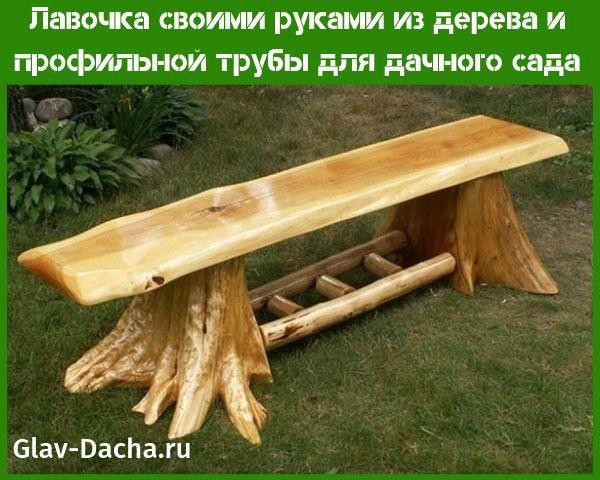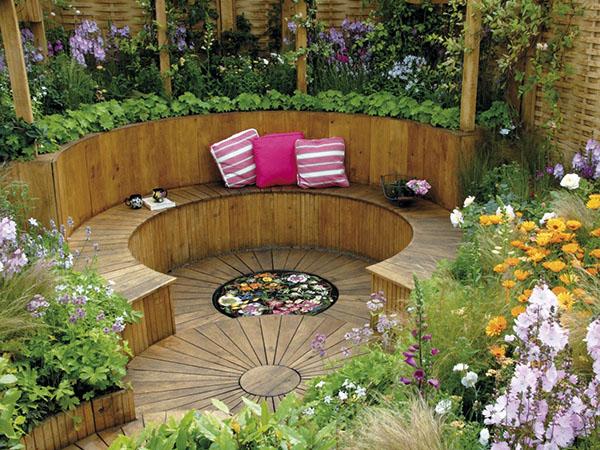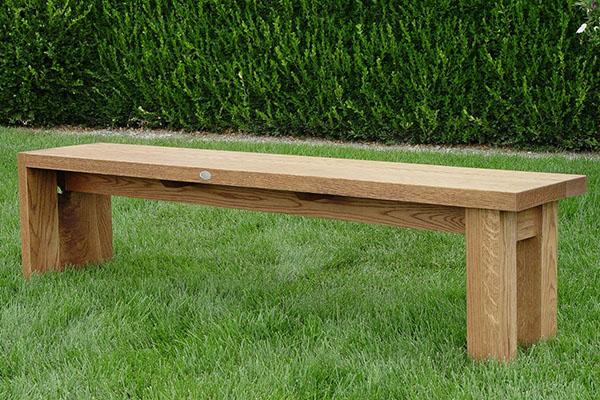A do-it-yourself bench made of wood and a profile pipe for a country garden
 An interestingly executed bench is not just garden furniture for relaxation. A do-it-yourself shop can decorate every site.
An interestingly executed bench is not just garden furniture for relaxation. A do-it-yourself shop can decorate every site.
It can be done in a certain style for a particular landscape design. Or just from the materials at hand according to their own design. Place benches anywhere - near the house, pool, in the patio area or B-B-Q, in the garden.
Do-it-yourself shop for giving

The main advantage of such furniture is its mobility. If, for example, a fountain had to be made in the place where the bench stands, it is easy to move it.
Materials for a do-it-yourself shop

Traditionally, benches are made from:
- Wood (teak, pine, oak, hazel, larch) is a durable and harmless material. Even deliberately rude products from it look stylish and original.
- Metal. You can make benches yourself from a profile pipe - they are practical, resistant to atmospheric precipitation, and do not require special care.
- Stone. The monumental nature of such benches requires space, so they are installed in large gardens.
- Plastic - finished products are lightweight, practical and cheap. You can make it yourself from plastic pipes.
- Vines, rattan. Wicker benches for summer cottages look great not only on the site, but also indoors, on the veranda, terrace, and more.
Recently, there is a new material called hularo - synthetic rattan based on rubber. It does not fade in the sun and is moisture resistant.
How to make a bench out of wood
 The economy version bench is made of pallets or building pallets, which can be purchased for "pennies".
The economy version bench is made of pallets or building pallets, which can be purchased for "pennies".
You need to pay attention to the step of the boards - it should not be very large. It is also desirable that a corner chamfer be removed along the contour.
A garden bench can also be made of boards and beams. To do this, you should:
- Cut the seat from the board (40-50 cm), grind.
- Saw off 4 legs for the legs and 2 for the rungs - 1 for each pair.
- Collect the bench and paint.
 A more complex design - with a backrest, you need to do it according to the schemes. Do-it-yourself drawings of a wooden bench will help you make it right.
A more complex design - with a backrest, you need to do it according to the schemes. Do-it-yourself drawings of a wooden bench will help you make it right.
From the materials you need to prepare:
- board 15 x 150 cm - 5 pcs;
- for the rear legs a board 14 x 72 cm - 2 pcs;
- a board for front legs 14 x 36 cm - 2 pcs;
- a block from a board of 50 cm with a section of 4 x 8 cm to strengthen the structure - 4 pcs;
- a board for strengthening the bottom 127 cm - 1 pc.
The thickness of the board is 4 cm.Also, to make a do-it-yourself bench from wood, you will need:
- jigsaw;
- electric planer;
- screwdriver;
- self-tapping screws;
- sandpaper;
- primer;
- varnish.
Step-by-step instruction
 Step 1. Saw with a jigsaw and grind the workpieces (dimensions are indicated in the drawings), it is better to round the edges.
Step 1. Saw with a jigsaw and grind the workpieces (dimensions are indicated in the drawings), it is better to round the edges.

 Step 2. Since the rear legs are at the same time the base of the backrest, they should be slightly beveled in the upper part (from the middle) so that the slope at the backrest is comfortable (20 about).
Step 2. Since the rear legs are at the same time the base of the backrest, they should be slightly beveled in the upper part (from the middle) so that the slope at the backrest is comfortable (20 about).
Step 3. First, assemble the legs with double strapping (top and bottom).
Step 4. Then the sidewalls are connected with seat boards.
 Step 5. Mount the back boards.
Step 5. Mount the back boards.
Fastening is done with self-tapping screws, sinking them into the wood. The last stage is deep antiseptic impregnation of wood and covering it with yacht varnish.
Profile pipe bench
 In this case, the metal is used only for the legs and frame.The back and seat will be made of wood.
In this case, the metal is used only for the legs and frame.The back and seat will be made of wood.
For work you will need to prepare:
- profile pipe with a section of 2.5 x 2.5 cm - 8 m;
- a board 6 x 160 cm, 3 cm thick (for the seat) and 2 cm (for the back);
- bolts with nuts - 24 pcs.
A piece must be cut from the pipe for the crossbar (155 cm), which will be located between the supports. Another 2 pieces of 35 cm for the base, 2 for the front legs of 39 cm, 2 for the rear legs (bent) for 78 cm and 4 plates 4 x 4 cm for the bottom of the legs.
The bending span (distance of the ends) of the bent parts should be 100 cm.
When all the parts of the frame are prepared, they are connected by welding in the following sequence:
- perpendicularly welded segments of 35 cm and a transverse beam (155 cm), while it is located in the center of short pipes;
- then bent parts are welded to the resulting structure - the rear legs (78 cm) just below the fold;
- the front legs are attached to the frame at a distance of 9 cm from the edges;
- for strength, the front legs and the crossbar are additionally connected with pipes;
- square plates are welded to the ends of the supports;
- the welding points are ground, the frame is cleaned, primed and covered with anti-corrosion paint.
For fastening the boards of the seat and back, holes are made (according to preliminary marking). Boards are treated with an antiseptic, varnish and "set" on bolts.
If you wish, you can make armrests, for which you can bend pieces of pipe (75 cm each) with a pipe bender and weld them to the frame.
Do-it-yourself photo of wooden benches
 Most often, there are benches with backs, and this is not surprising - they are comfortable to sit on, leaning back and relaxing your back.
Most often, there are benches with backs, and this is not surprising - they are comfortable to sit on, leaning back and relaxing your back.
Moreover, wood can be of various types: bar, board, branches, logs. It is much easier to make a regular shop. Usually they create a set of 2 benches and a table.
The logs look more massive and complement the garden design well, giving the impression of reliability and antiquity.
A bench with a back entwined with branches or vines looks original and natural. It gives lightness and grace to a small architectural form.
Wood is an ideal material for carving. Craftsmen can create a real masterpiece from an ordinary bench.
Photos of wrought iron benches
Forged benches and benches are widely used as a functional design of a suburban area. They can be very different.
 With a back in the form of a tree with foliage.
With a back in the form of a tree with foliage.
 Openwork lightness of metal.
Openwork lightness of metal.
 Cold forging.
Cold forging.
 Laconicism and style.
Laconicism and style.
 Nobility and elegance.
Nobility and elegance.
The shops and benches with wrought iron elements testify to the impeccable taste of the owners. Whatever material is chosen, the main thing is that the bench or bench is comfortable and everyone loves it.